Any thoughts about this? Doesn't it concern you? Thanks."

The previous thread was extremely long.
https://www.marketforum.com/forum/topic/98093/
I'll copy the last 2 exchanges below.
From WxFollower:
https://www.marketforum.com/forum/topic/98093/#98319
Re: Hawaii wildfire at Lahaina (on Maui): CC blamed as a factor
By WxFollower - Aug. 16, 2023, 5:44 p.m.
Hey Mike,
Continued from before, here was a reply I just gave to chubbs (I think it's pretty good):
-----------
"Thanks. In Swain's article, he says:
'climate change–which is likely increasing the duration and severity of droughts on the lee sides of the islands and the intensity of wet-dry cycling of precipitation (which favors extra vegetation growth, and then rapid drying of that extra growth during high risk periods).'
Then you restated Swain's idea of wetter wet seasons and drier dry seasons.
But then I read this from your last link about expected changes on Hawaii, itself, due to CC written by Kevin Hamilton:
'We found that in the wet windward areas of Hawaii, rainfall is projected to increase substantially. That includes increasingly frequent extreme downpours. On the other hand, rainfall is predicted to decrease substantially over much of the rain shadow regions.'
So, to recap, Swain is suggesting wetter wet seasons and drier dry seasons. But Hamilton is instead suggesting wetter windward areas and drier leeward areas.
So, Swain implies CC causes Lahaina to have both wetter winters (causing increased vegetation) and drier summers (causing more fire danger due to more fuel available that dries out in summer).
But Hamilton is implying CC causes both winter and summer to be drier at Lahaina. So, per Hamilton, there actually isn't the increased fuel at Lahaina due to wetter winters.
So, Swain (wetter) and Hamilton (drier) are literally on opposite sides on how CC affects Lahaina winter rainfall.
Any thoughts about this? Doesn't it concern you? Thanks."
-----------------
Mike, I'll post here any reply he gives.
---------------
**Edit: I just got chubbs' civil answer:
"Yes, they do not appear to be consistent. I would go with the local expert Hamilton. Swain may be wrong or I could have misinterpreted what he means by wet-dry cycling. It could be that the rain shadow areas are getting less frequent rain but when it does rain the rain is heavier. Increased precipitation intensity even in areas that receive less rain is mentioned in the abstract of the first reference I provided."
+++++++++++++
Re: Hawaii wildfire at Lahaina (on Maui): CC blamed as a factor
By WxFollower - Aug. 16, 2023, 6:16 p.m.
Hey Mike,
Here in the SE US I've noticed a significant rise in dewpoints and associated average morning lows over the last few decades in the summer. This has to be due to GW induced warmer SSTs. Since the SE US has flow off the warm ocean to our south a larger % of the time in summer than other seasons, the influence of SSTs is higher then.
Here's something I've been wondering about. We both know that many climate researchers believe that AGW induced CC leads to more intense droughts. (I know you disagree as you said data doesn't support this.) We know that their idea is that higher temperatures lower RH, which leads to less rainfall overall. I understand that premise. No debate on that.
But here's my concern based on my experiences here. Aren't there also warmer dewpoints that come along with GW during seasons when air predominantly flows off the ocean as a result of the warmer SSTs that were already caused by GW? If air temps rise but also dewpoints rise, might RHs actually stay about the same in areas where and when flow off the ocean dominates?
So, I can understand the idea of dry areas not influenced much by ocean flow possibly becoming drier due to lower RHs. But what about areas that have ocean influence during certain or all times of year? Could it be that those areas aren't having much of an increase in drought, if any?
Also, is it possible that dewpoints everywhere are rising? IF so, are they rising as fast as temperatures? For example, world temps have increased ~2-3 F due to AGW. Have dewpoints increased by that much or by a smaller amount? If the increase has been the same, then average RH wouldn't have dropped. But if by a smaller amount, then average RH would have dropped this leading to increased drought.
---------------
**Edit: Please go back up one post to make sure you read the brand new reply from chubbs to my last post to him that I just edited in at the end.
++++++++++++++++++++
Response by metmike:
Re: Re: Hawaii wildfire at Lahaina (on Maui): CC blamed as a factor By metmike - Aug. 17, 2023, 12:28 a.m.
Larry,
I was starting to get frustrated, having to repeat the same things over and over in response to your person's comments.........then, you just made my day with your last post.
Thank you for having your thinking cap on and using personal observations, along with critical thinking instead of just believing the mainstream narratives about drought.
Absolutely dew points are higher in most places. This is the major reason why global drought has decreased slightly NOT increased DESPITE models predicting that drought will increase and the majority of people that follow models (almost like a religion) are convinced that drought will increase. But they will continue to be wrong.
Thanks to your point and photosynthesis, I'll explain exactly why they continue to be wrong.
You might remember we had a poster here, WxGrant, who was a television meteorologist from MO.
The 2 of us had some wonderful discussions on weather.
I copied the link to this one which your post jogged my memory about. You'll love it:
Corn and climate change
13 responses |
Started by metmike - Dec. 6, 2018, 10:43 a.m.
https://www.marketforum.com/forum/topic/18987/
https://www.marketforum.com/forum/topic/18987/#19020
This is why I say that climate change is helping to protect us from weather/climate like the Dust Bowl, a decade with numerous years of extreme drought and the hottest weather in U.S. history by an extremely wide margin.
It's not just the atmosphere holding more moisture and dew points being higher.
The world is massively greening up by every measure. Even deserts are greening up.
CO2 increasing by 130 ppm has led to plants growing 26% faster/bigger......EVERYWHERE, not just the Midwest.
The Midwest has sort of been a real world laboratory to demonstrate an amplified version of the impact of the increase in EVAPOTRANSPORATION from the massively greening up world.
The higher the CO2 is, the greater the vegetation/plant growth, the greater the evapotransporation, the higher the dew points, the more the rainfall.
If you hold all things the same but increase the dew point by a few degrees, there will always be more rain days and heavier rains, even with warmer temperatures.
Evapotranspiration only happens in the growing seasons. For the tropics, this is year round. The farther north you go, the shorter the time frame/growing season but once plants come out of dormancy, evapotranspiration kicks in.
im thinking that evapotranspiration might not be as big of a deal on an island surrounded by water. But if the water is warmer…the dew points WILL BE higher.
but let’s expand the conversation to being profound and include evapotranspiration with respect to the climate models and drought.
Here's the thing. Global climate models DON'T have this dialed in. This is a huge reason for why they keep predicting more drought..........while we continue to have LESS drought.
The U.S. Cornbelt has had only 1 widespread severe drought that lasted thru much of the growing season since 1988 (2012 was the year).
Historically, the Cornbelt averaged 1 severe widespread drought every 8 years or so.
In the 1930's, half of the years featured widespread severe droughts.
This is not from a natural cycle or other reason. It's mostly because of climate change. We can thank farming for much of that, with the tightly packed rows of corn greatly amplifying the impact which is being experienced EVERYWHERE there are plants.
Again, those plants are growing 26% bigger/faster everywhere nd increasing evapotranspiration, which recycles moisture(returning as additional rains because of the increase in low level moisture, all things the same).
The increase in vegetation is also a negative feedback to increasing daytime readings.
As you noted, the night time/very early mornings are the time of day that is warmer vs 40 years ago. In the Midwest, in fact, its become extremely rare to have 100+ readings in the Summer.
Those lower daytime readings are also a factor in less drought.
++++++++++++
Hawaii wildfire at Lahaina (on Maui): CC blamed as a factor
By metmike - Aug. 17, 2023, 12:51 a.m.
https://www.marketforum.com/forum/topic/45281/#47435
Those areas mentioned above have had below average rains this growing season. If not for the huge increase in CO2 the past 100 years, crop conditions would have deteriorated much more. Increased CO2, besides acting as atmospheric fertilizer also causes plants to be more water efficient. They don't need to open their stomata as wide or as often to let CO2 in. As a result, they lose less water/moisture from evapotranspiration. Soybeans are a C3 plant. C3 plants benefit the most from the increase in CO2.
The preceding discussion has presented the average effects of elevated CO2, but obscures important patterns of difference in response among plant species. One of the most important determinants of species differences in response to elevated CO2 is photosynthetic type. Most plant species (~90%) utilize a photosynthetic process known as C3 photosynthesis. Other species use either of two physiologically distinct processes known as C4 and CAM photosynthesis (Figure 2). C4 plants include most tropical and sub-tropical grasses and several important crops, including maize (corn), sugar cane, sorghum, and the millets. There has therefore been considerably more research on the responses to elevated CO2 in C4 than in CAM plants.
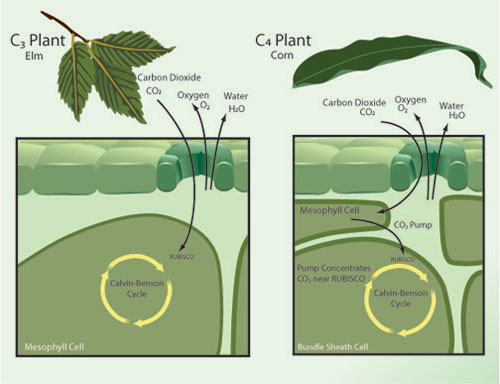
Figure 2: Each plant species utilizes one of several distinct physiological variants of photosynthesis mechanisms, including the variants known as C3 and C4 photosynthesis.
"Current evidence suggests that the concentrations of atmospheric CO2 predicted for the year 2100 will have major implications for plant physiology and growth. Under elevated CO2 most plant species show higher rates of photosynthesis, increased growth, decreased water use and lowered tissue concentrations of nitrogen and protein. Rising CO2 over the next century is likely to affect both agricultural production and food quality. The effects of elevated CO2 are not uniform; some species, particularly those that utilize the C4 variant of photosynthesis, show less of a response to elevated CO2 than do other types of plants. Rising CO2 is therefore likely to have complex effects on the growth and composition of natural plant communities."
++++++++++++++++
Larry,
We should note below, what happens when they use modes that dial in the reality of photosythesis.
Look at the massive, continuous increase in the greening (leaf area) for our planet thru the year 2100.
This increase in greening from leaves, also means an increase in evapotranspiration from those leaves, similar to but not as amplified as the U.S. Cornbelt.
https://www.marketforum.com/forum/topic/69258/#69259
https://earthobservatory.nasa.gov/images/146296/global-green-up-slows-warming
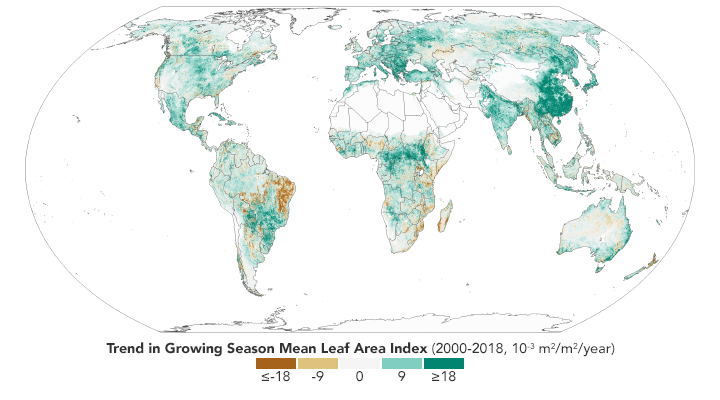
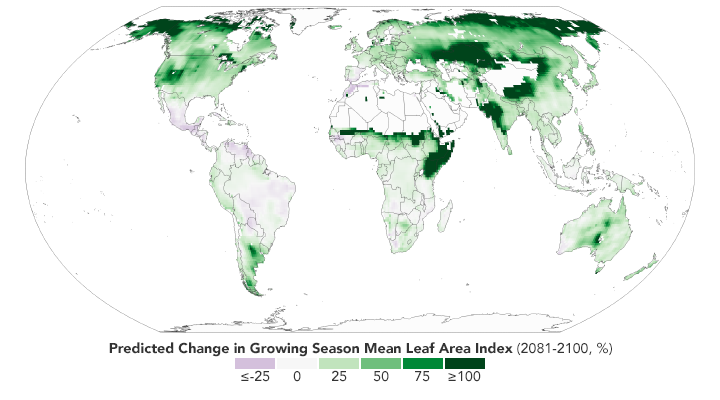
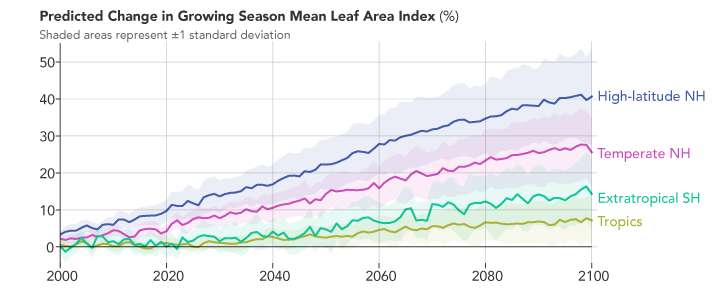
"The paper’s authors reviewed more than 250 published articles that have used satellite data, modeling, and field observations, to understand the causes and consequences of global greening. Among the key results, the authors noted that on a global scale greening can be attributed to the increase of carbon dioxide in the atmosphere. Rising levels of carbon dioxide increase the rate of photosynthesis and growth in plants."
metmike: Why isn't this paper, based on 250........let me repeat that number 250 published articles using the best technology known to science............getting much news coverage?
Because they don't want you to know this.
From the projections: According to climate models, the future looks even greener. The second map shows what the green-up might look like in the future based on the Coupled Model Intercomparison Project (CMIP5) climate model, under a scenario in which increases in greenhouse gases lead to almost 5° Celsius (9° Fahrenheit) of warming by the end of the 21st century. Specifically, it shows the predicted change in the growing season’s “leaf area index” from 2081-2100 relative to 1981-2000. The chart below the map shows the predicted changes by latitude. Notice that high latitudes in the Northern Hemisphere are still expected to change the most.
metmike: There is almost no chance we will see that amount of warming.
Re: Hawaii wildfire at Lahaina (on Maui): CC blamed as a factor By metmike - Aug. 17, 2023, 1:09 a.m. Cooling of US Midwest summer temperature extremes from cropland intensification
https://www.nature.com/articles/nclimate2825
Here we identify centennial trends towards more favourable growing conditions in the US Midwest, including cooler summer temperature extremes and increased precipitation, and investigate the origins of these shifts.
++++++++++++++++

++++++++++++++++++++++++++++++++++++++++++++++++++++

I don't care how many global climate models tell us that climate change is increasing drought or how many really smart biased scientists that believe in the models tell us that climate change is increasing global drought or how many times they cherry pick dry places and try to use that as evidence(as if new droughts never emerged before human caused climate change)
THEY ARE WRONG!
Desertsgreening up from rising CO2 below:
https://phys.org/news/2013-07-greening-co2.html

Increased levels of carbon dioxide (CO2) have helped boost green foliage across the world's arid regions over the past 30 years through a process called CO2 fertilisation, according to CSIRO research.
In findings based on satellite observations, CSIRO, in collaboration with the Australian National University (ANU), found that this CO2 fertilisation correlated with an 11 per cent increase in foliage cover from 1982-2010 across parts of the arid areas studied in Australia, North America, the Middle East and Africa, according to CSIRO research scientist, Dr Randall Donohue.
++++++++++++
Considering the fact that models continue to be wrong about global drought increasing (which I proved as an authentic fact), if they can't even get the sign correct for drought increasing/decreasing for the planet, it's pretty absurd to be having a debate over whether global climate models can reliably predict the increase/decrease in rains over 1 island in the middle of the Pacific out to the year 2100.
One reason that you have 2 scientists contradicting each other on this is that the current models don't have enough skill to forecast this with precision. Picking one scientist over the other for whatever reason is equally absurd.
I know exactly what its like when a meteorologist makes a weather forecast and WANTS to believe in the model his/her forecast is using to base it on.
Climate scientists and modelers are doing the exact same thing..........except, unlike the local meteorologist that wouldn't change their weather forecast for clear skies, even while looking at rain on the radar and pretending its not there..........who has egg on their face.
Climate scientists NEVER have to reconcile their bad predictions to the observations.
Instead, as part of the hijacking of climate science, they control the narratives and the data reporting. They and the models are ALWAYS right (even when wrong) . Because they are infallible, they never need to adjust the models, except to make them hotter recently so they would scare more people into believing that we're killing the planet and need to act ASAP because human civilization is gravely threatened.
ironically, the biggest threat comes from their solutions. I’ve mentioned the great harm that wind turbines and batteries do to the planet With the biggest impact of fossil fuels coming from greening the planet 26%.
we should appreciate them NOT telling us this scientific fact because it contradicts the narrative about the fake climate crisis.
its impossible for most people to comprehend this because we NEVER hear that and are taught the opposite…that 2+2=5.
but you are different than most people and can use well developed critical thinking and gifted analytical skills to apply objective, authentic science instead of letting your intelligence get stolen by years of junk science rhetoric.
This was my comment:
Mike Maguire
August 17, 2023 6:09 am
Blaming climate change and telling us that the solution is to cut CO2 by eliminating fossil fuels is extremely COUNTER productive because, not only is it wrong but it focuses on a non problem instead of addressing the real problems that can be fixed to save lives.
My years of working with the NWS, NOAA, Storm Prediction Center, National Hurricane Center and other entities that deliver timely messages to alert U.S. citizens to life threatening risks has been loaded with positive experiences and admiration but most of all, appreciation to them for saving tens of thousands of lives over the last century and giving operational meteorologists like me the information to pass on to people that follow us.
However, it’s extremely sad to have to fault the entities in Hawaii responsible for protecting lives in this situation for completely failing in catastrophic and numerous ways.
There were no warnings with a siren system that is tested monthly and designed for natural disaster/weather emergencies.
The lack of planning and lack of a mitigation strategy was malpractice and negligence.
At the very least, they should have controlled the invasive grass growth/fuel load. Spraying an effective herbicide over large areas in a strategic manner to kill or stifle the grass growth using misters could have cut off the fires access to unlimited fuel heading in the direction of the wind.
Herbicidal Weed Control Methods for Pastures and Natural Areas of Hawaii
https://www.ctahr.hawaii.edu/oc/freepubs/pdf/WC-8.pdf
Application techniques and equipment:
Also, cutting that grass in some sections, especially surrounding the most vulnerable areas…… around power lines or ignition sources was an option.
The problem with cutting the grass is that it will grow back. An herbicide lasts much longer.
These are my GENERAL suggestions:
1. Effectively identify the risk areas. Including those that seem far fetched but under the most anomalously dry and windy weather, have the fuel load to cause a massive fire, especially where people live.
2. Take actions to have a warning system in place……..like using tornado/severe weather warning sirens in the earliest stages of the event, so that people can evacuate in timely fashion.
3. Provide educational information so people understand the risk and know what to do.
4. Extremely important. Practice Mitigation. In higher risk areas, reduce vegetative fuel loads/ignition sources and use known principles that apply locally to each situation to reduce the risks.
5. Stop blaming climate change. It misleads and diverts attention and resources away from PROVEN strategies above that can be used to save lives.
Managed Fires Can Help Mitigate the Risks Posed by Increasing Frequency of Wildfires in some places.
Wildfire Mitigation and Adaptation Guide for Homeowners
https://climatecheck.com/risks/fire/mitigation-guide-for-homeowner
https://wildfiremitigation.tees.tamus.edu/faqs/how-power-lines-cause-wildfires
Power lines have caused more than 4,000 wildfires in Texas in the past three and a half years. Power lines can ignite wildfires through a variety of mechanisms.
https://newscenter.sdsu.edu/sdsu_newscenter/news_story.aspx?sid=79257
Larry,
After reading this article/explanation by Cliff Mass, I think you will truly appreciate my putting this guy up on a pedestal for sources of comprehensive, authentic meteorology, climate and science.
From the Cliff Mass Weather Blog
https://wattsupwiththat.com/2023/08/16/the-real-cause-of-the-maui-wildfire-disaster/
The Bottom Line
The Maui event was the result of a high amplitude mountain wave and strong, dry downslope flow on the western slopes of the mountains of West Maui. The mountain wave was the result of strong approaching flow and a stable layer near the crest level of the Maui Mountains.
Strong dry winds support fire and result in rapid movement of the flame front, as well as moving embers ahead. The winds could well have started the fire by damaging infrastructure. As noted in my earlier blog, a huge reserve of dry, flammable grasses was in place.
This event was not the result of climate change, Hurricane Dora, or an extended drought. It resulted from an unusually intense mountain wave/downslope windstorm produced by a fairly rare convergence of conditions.
This event was highly predictable using modern weather prediction technology. The combination of a reasonable weather observing network (which does not exist on Maui) and the use of state-of-science weather modeling, the population of Maui can receive far better warnings that can prevent this tragedy from occurring again.
Some of the most incredible video footage ever...... shocking and haunting in some cases. This was in the previous thread but its just so powerful that it justifies using more than once.
Drone footage:
https://twitter.com/i/status/1690414307979169792
I found this incredible video from Dr. Daniel Swain, using a drone that actually shows how fast the fire was spreading.
North Kihei fire filmed at 11:30 PM
https://www.youtube.com/watch?v=6W_Ra22W5SQ
++++++++++++++++++++++++
Shadab Javed@JShadab1
Video footage of 8th of August before fires started in #Lahaina Electric poles falling off. May be this could be one of the reason of the deadly wildfires. Follow for more updates. Video Credits – @livingearthsystems (Instagram handle)
https://twitter.com/i/status/1690415918453800961
++++++++++++++
Mike@PantherMike182
Humanity is dead. They just drove right past her and left her for dead…
https://twitter.com/i/status/1689409366984949760
+++++++++++++++++
Shadab Javed@JShadab1
Devastating People of #lahaina wanted to share their first hand experience in the Lahaina fires. They wanted the world to see the reality of the situation. Follow for more stories.
https://twitter.com/i/status/1690431105080713216
++++++++++
Ivan@Ivankalema01
The historic town of Lahaina was leveled The death toll from the devastating wildfires in Maui, Hawaii has reached 80. Thousands of people have been displaced, more than 1,700 structures have been destroyed.
https://twitter.com/i/status/1690344115223838721
++++++++++++++
@NikkiThaGodB1
Horrible aftermath of devastating fires in #Maui as death toll continues to rise.
https://twitter.com/i/status/1690378561964625920
Larry,
You had mentioned higher dew points where you live in GA. In case you didn't notice in the thread with Grant, we discussed the much higher dew points in Corn fields that included this comment:
https://www.marketforum.com/forum/topic/18987/#19515
For sure these higher dew points are causing much heavier downpours and even without the effect from corn evapotranspiration, the warmer atmosphere (which can hold more moisture) has resulted in an increase in flooding events.
When I started analyzing weather in the early 1980's, an 80 degree dew point was a freakish, isolated occurrence in the cornbelt that didn't happen in most Summers.
The chart below, is for the average number of 80 degree dew point days. Since it goes back 4 decades, the average for much of Iowa, is around .5/year, so 1 time every 2 years.
I would venture to guess that in the 70's/80's it was more like 1 time every 5-10 years.
In the last 20 years, maybe more than 1+ time/year?
https://mesonet.agron.iastate.edu/onsite/features/cat.php?day=2017-07-21
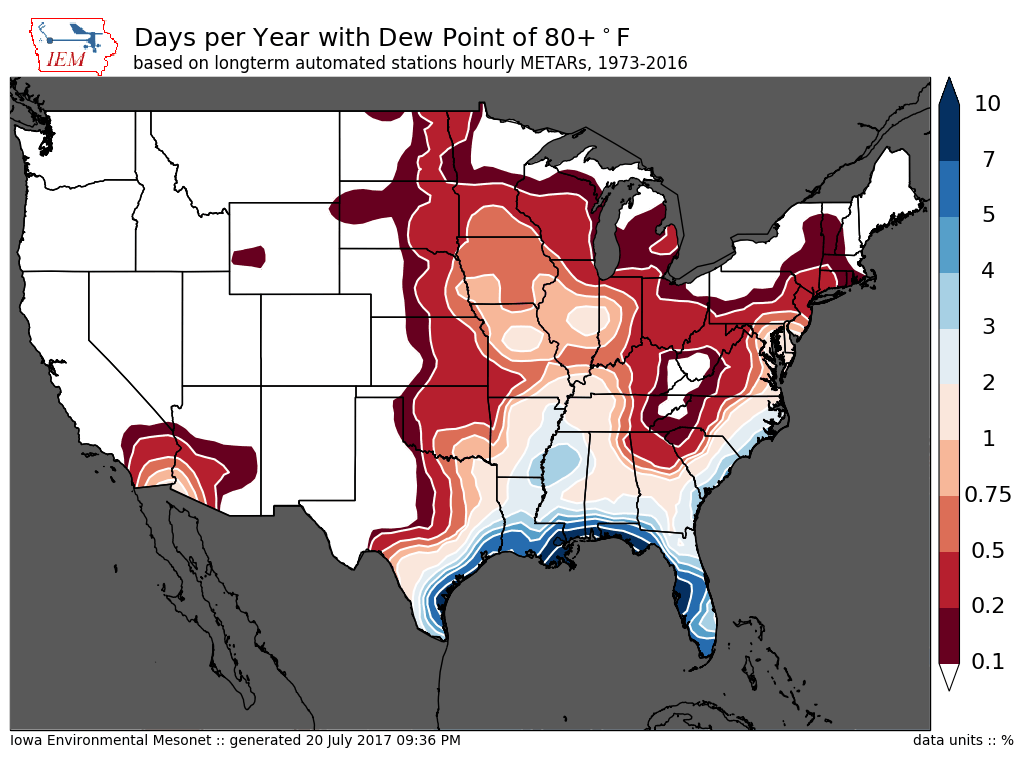
++++++++++++++
This is such a profoundly fascinating topic, so here's more.
An acre of corn can add up to 4,000 gallons of water vapor to the atmosphere per day!
++++++++++++++++
Can you imagine stepping outside to a 90-degree dew point?
https://www.foxweather.com/learn/corn-sweat-midwest-most-oppressive-humidity-united-states
Some 130 miles west of Clarion in Maurice, Iowa, an even higher dew point of 91 degrees was recorded the previous evening, between 5-7 p.m. Central time on July 27, 2021. The 5 p.m. air temperature was 93 degrees, making the heat index an astounding 141 degrees.
According to an August 2011 blog post by weather historian Christopher Burt at Weather Underground, the highest dew point ever reliably measured in the United States was 91 degrees in Melbourne, Florida, at 2 p.m. Eastern time on July 12, 1987. That was accompanied by an air temperature of 95 degrees, so the heat index was a stifling 144 degrees (in case you were keeping score at home).
+++++++++++
https://www.kcrg.com/content/news/WWC-Why-have-dew-points-been-jumping-up-in-the-evening-487803471.html
+++++++++++++
Climate Change Impacts in the Corn Belt
https://www.researchgate.net/publication/250221814_Relating_changes_in_agricultural_practices_to_increasing_dew_points_in_extreme_Chicago_heat_waves
Event average hourly dew-point values before the mid 1980s were generally below 21degreesC, rising to an average of 24degreesC during the mid 1990s. The temporal changes in dew-point values were related to 2 factors: (1) the existence of average to above-average regional precipitation anomalies occurring in May and during the 20 d period prior to the heat event, and (2) changes in agricultural practices that have led to enhanced evapotranspiration rates in the Midwest.
++++++++
https://www.researchgate.net/publication/250172035_Midwestern_High_Dew_Point_Events_1960-2000

+++++++++
22 Deg. C = 71.6 Deg. F
Note that before 1986, high dew point events that matched this definition were almost unheard of. I will bet you that we have them at least once every year now and probably several times/year.
++++++++++++++
I was surprised that this graph doesn't show much change in Dew Points at this station in Minnesota.
Note that just before and during the Dust Bowl 1930's was the longest period with low dew points was recorded.........during several of the HOTTEST Summers for day time readings on record.
The recent spike down in 2009, corresponded to one of the coolest Summers of the last 100 years.
https://www.dnr.state.mn.us/climate/twin_cities/mspdewpoint.html

Iowa on the other hand, shows around a +2.5 deg F increase in Summer dew points.
Keep in mind that IA has actually seen a slight DECREASE in Summer daytime temperatures in recent decades(because of man made climate change-evapotranspiration from the massive increase in agricultural vegetation)

Bjorn Lomborg said Friday that politicians were blaming climate change for disasters like the wildfires on Maui to duck “responsibility” for “failures” in addressing them.
Democratic Gov. Josh Green of Hawaii blamed climate change for the deadly wildfire that destroyed many buildings in the town of Lahaina, killing at least 96 people as of Monday, according to the New York Times. The West Maui Land Company accused M. Kaleo Manuel, an official with the Hawaii Department of Land and Natural Resources (DLNR), of delaying a response to a request to use water to refill reservoirs used by the Maui Fire Department to fight the wildfire, Hawaii News
+++++++++++++++++++++++++++
+++++++++++++
‘Horrible, Horrible Disservice’: Tulsi Gabbard Unloads On Biden Admin’s Response To Maui Wildfire)
https://www.washingtonexaminer.com/opinion/climate-activists-are-getting-people-killed
+++++++++++++=
The article below is pay walled:
https://www.wsj.com/us-news/wildfire-risk-maui-hawaiian-electric-7beed21e
++++++++++++++
I've been spelling this exact same message out for over a week now:
It bears reminding, since most sources are stating the complete opposite for their agenda, this wildfire had nothing to do with climate change as proven indisputably with the comprehensive date in the posts of the 2 threads above.
This once again boils down to objective empirical data representing authentic science vs scary alarmist verbiage, exaggerations/misleading, cherry picking and flat out lying.
Using a horrible, tragic event to serve the objectives of the fake climate crisis rather than seek just accountability to learn lessons in order to make common sense adjustments that result in life saving mitigation which is clearly within our reach :
https://apnews.com/article/hawaii-maui-lahaina-fire-dead-missing-fb8592496f400e995266944ffb16a7e7
++++++++++++++
‘Aloha Spirit’ Rises From the Ashes on Maui
Community outreach and prayer offer ‘glimmer of light.’
++++++++++++
Not too many organizations can do better than the Catholic Church when it comes to helping those in need, especially during the most critical times.
cutworm can vouch for this!